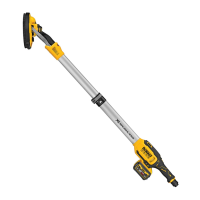11
ENGLISH
Sanding Drywall (Fig. K)
WARNING: To reduce the risk of personal injury,
ALWAYS wear a respirator approved by NIOSH for
“Dust andMist”.
Installing and Removing the Battery Pack
(Fig. J)
NOTE: For best results, make sure your battery pack is
fullycharged.
To install the battery pack
1
into the tool handle, align the
battery pack with the rails inside the tool’s handle and slide
it into the handle until the battery pack is firmly seated in
the tool and ensure that it does notdisengage.
To remove the battery pack from the tool, press the release
button
2
and firmly pull the battery pack out of the tool
handle. Insert it into the charger as described in the charger
section of thismanual.
No-Volt
The No-volt function stops the sander from restarting
without the switch being cycled if there is a break in the
powersupply.
Slider Switch (Fig.E)
NOTE: To reduce unexpected tool movement, do not
switch the tool on or off while under load conditions. Allow
the sander to run up to full speed before touching the work
surface. Lift the tool from the surface before turning the tool
off. Allow the tool to stop rotating before putting itdown.
WARNING: Before connecting the tool to a power
supply, be sure the slider switch is in the off position
by pressing the rear part of the switch and releasing.
Ensure the slider switch is in the off position as
described above after any interruption in power
supply to the tool, such as deadbattery.
To start the tool, slide the ON/OFF slider switch
3
toward
the front of the tool using the rear portion of the switch. To
stop the tool, release the ON/OFF sliderswitch.
For continuous operation, slide the switch toward the front
of the tool and press the forward part of the switch inward.
To stop the tool while operating in continuous mode, press
the rear part of the slider switch andrelease.
Proper hand position requires one hand on the main
handle
5
and one hand on the main tube
6
.
Proper Hand Position (Fig. A, K)
WARNING: To reduce the risk of serious personal
injury, ALWAYS use proper hand position as shown.
WARNING: To reduce the risk of serious personal
injury, ALWAYS hold securely in anticipation of a
suddenreaction.
Precautions to Take When Sanding Paint
Sanding of lead based paint is NOT RECOMMENDED due
to the difficulty of controlling the contaminated dust.
The greatest danger of lead poisoning is to children and
pregnantwomen.
Since it is difficult to identify whether or not a paint contains
lead without a chemical analysis, we recommend the
following precautions when sanding any paint:
1. PERSONAL SAFETY
- No children or pregnant women should enter the
work area where the paint sanding is being done
until all clean up iscompleted.
- A dust mask or respirator should be worn by all
persons entering the work area. The filter should be
replaced daily or whenever the wearer has difficulty
breathing. See your local hardware store for the
proper NIOSH-approved dustmask.
- NO EATING, DRINKING or SMOKING should be done
in the work area to prevent ingesting contaminated
paint particles. Workers should wash and clean up
BEFORE eating, drinking or smoking. Articles of food,
drink, or smoking should not be left in the work area
where dust would settle onthem.
2. ENVIRONMENTAL SAFETY
- Paint should be removed in such a manner as to
minimize the amount of dustgenerated.
- Areas where paint removal is occurring should be
sealed with plastic sheeting of 4 milsthickness.
- Sanding should be done in a manner to reduce
tracking of paint dust outside the workarea.
The drywall sander has an articulating sanding head. The
head can swivel in multiple directions, allowing the abrasive
pad to conform to the work surface. This action enables you
to sand the top, middle, and bottom of a wall or ceiling joint
without changingposition.
1. Turn the vacuum cleaner switch ON (I).
2. Turn drywall sander switchON.
3. Position the drywall sander lightly against the work
surface. Apply just enough pressure to align the sanding
head with the worksurface.
4. Apply additional pressure to engage the abrasive pad
on the work surface. Move the sander in an overlapping
pattern to smooth the drywall compound down to
a“featheredge”.
5. Apply ONLY enough pressure to keep the abrasive pad flat
against the work.
6. Keep the sander in constant motion while the abrasive
pad is in contact with the work surface. Use a steady,
sweeping motion. Excessive pressure, stopping the
sander on the work, or moving the sander erratically can
cause unacceptable swirl marks and unevenness in the
worksurface.
NOTE: Do not allow rotating abrasive pad to contact sharp
protrusions. Contact with protruding objects (nails, screws,
electrical boxes, etc.), can severely damage the abrasivepad.
OPERATION
WARNING: To reduce the risk of serious personal
injury, turn unit off and remove the battery pack
before making any adjustments or removing/
installing attachments or accessories. An
accidental start-up can causeinjury.

